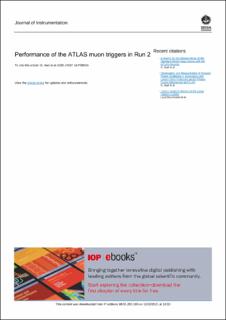Performance of the ATLAS muon triggers in Run 2
Aad, Georges; Abbott, Brad; Abbott, Dale C.; Abed Abud, Adam; Abeling, Kira; Abhayasinghe, Deshan Kavishka; Abidi, Syed Haider; AbouZeid, Ossama Sherif Alexander; Abraham, Nadine L.; Abramowicz, Halina; Bjørke, Kristian; Bugge, Magnar Kopangen; Cameron, David Gordon; Catmore, James Richard; Garonne, Vincent; Gramstad, Eirik; Heggelund, Andreas Løkken; Hellesund, Simen; Håland, Even Simonsen; Morisbak, Vanja; Oppen, Henrik; Ould-Saada, Farid; Pedersen, Maiken; Read, Alexander Lincoln; Rye, Eli Bæverfjord; Røhne, Ole Myren; Sandaker, Heidi; Serfon, Cédric; Vadla, Knut Oddvar Høie; Buanes, Trygve; Djuvsland, Julia Isabell; Eigen, Gerald; Feigl, Simon; Fomin, Nikolai; Lee, Graham Richard; Lipniacka, Anna; Martin dit Latour, Bertrand; Stugu, Bjarne; Træet, Are Sivertsen; Abreu, Henso; Abulaiti, Yiming; Acharya, Bobby S.; Achkar, Baida; Adachi, Shunsuke; Adam, Lennart; Adam-Bourdarios, Claire; Adamczyk, Leszek; Adersberger, Michael; Adigüzel, Aytül; ATLAS, Collaboration
Journal article, Peer reviewed
Published version

Åpne
Permanent lenke
https://hdl.handle.net/11250/2753225Utgivelsesdato
2020-09Metadata
Vis full innførselSamlinger
Originalversjon
Journal of Instrumentation (JINST). 2020, 15, P09015. 10.1088/1748-0221/15/09/P09015Sammendrag
The performance of the ATLAS muon trigger system is evaluated with proton-proton (pp) and heavy-ion (HI) collision data collected in Run 2 during 2015–2018 at the Large Hadron Collider. It is primarily evaluated using events containing a pair of muons from the decay of Z bosons to cover the intermediate momentum range between 26 GeV and 100 GeV. Overall, the efficiency of the single-muon triggers is about 68% in the barrel region and 85% in the endcap region. The pT range for efficiency determination is extended by using muons from decays of Jψ mesons, W bosons, and top quarks. The performance in HI collision data is measured and shows good agreement with the results obtained in pp collisions. The muon trigger shows uniform and stable performance in good agreement with the prediction of a detailed simulation. Dedicated multi-muon triggers with kinematic selections provide the backbone to beauty, quarkonia, and low-mass physics studies. The design, evolution and performance of these triggers are discussed in detail.
